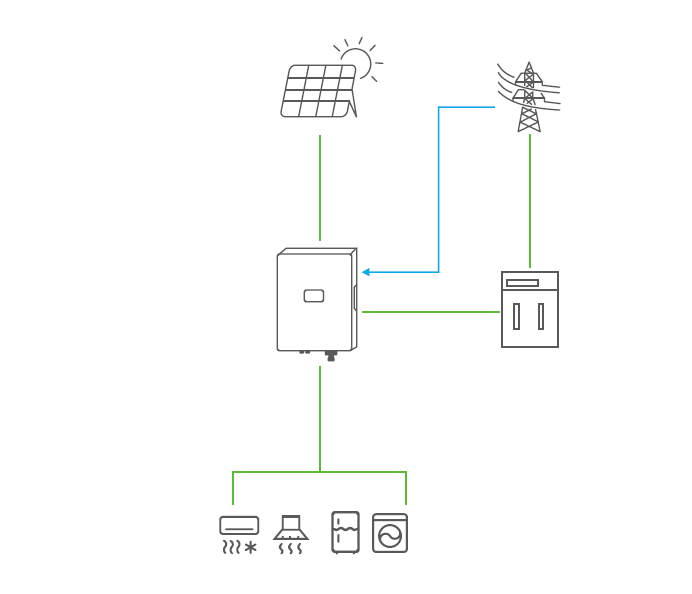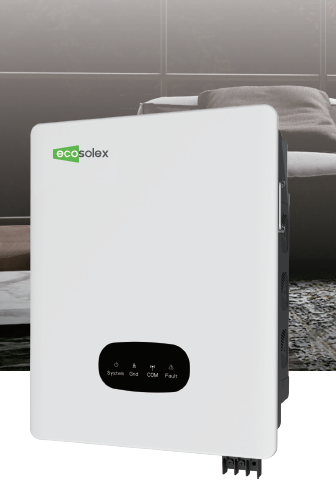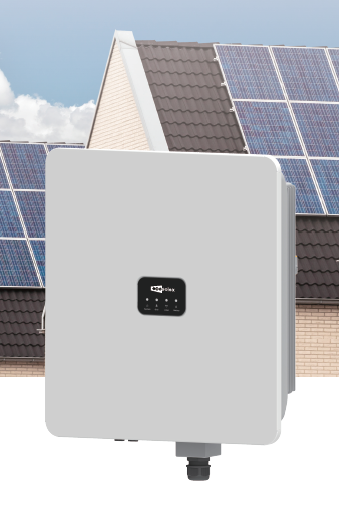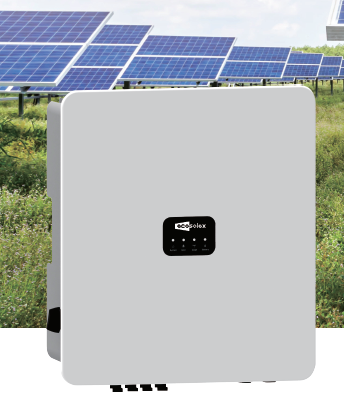In the era of strong development of renewable energy, solar inverters play a key role in converting solar energy into electricity for households, businesses and production facilities. Choosing high-quality inverters not only ensures optimal operating performance but also prolongs the life of the entire system, minimizing energy loss and operating costs. Modern inverter lines integrate many smart functions such as remote monitoring, optimizing power output according to light conditions, protecting against overload, short circuit, and flexible connection to the energy storage system (BESS).
What is Solar Inverter?
Inverter, also known as inverter, is an important electrical device in every solar power system. The main function of a solar inverter is to convert direct current (DC) produced by solar panels into alternating current (AC) suitable for electrical equipment in the home and connected to the national grid. Solar inverters take on the role of converting current, ensuring stable voltage, protecting equipment, and allowing surplus electricity to be exported to the grid (if the system is grid-connected).
A modern solar inverter not only converts electricity but also integrates smart features such as system monitoring, overload protection, short circuit protection, battery balancing and optimizing power output according to light conditions. This is why high-end solar inverters become the optimal choice for residential and commercial solar power systems.

Common Types of Inverters
In modern solar power systems, solar inverters are important devices that determine the efficiency and stable operation of the entire system. Depending on the needs of use and connection to the grid, solar inverters are divided into three main types:
On-grid Inverter
Grid-tie inverters are the ideal solution for households and businesses that want to optimize solar energy while using the national grid. This type of solar inverter converts direct current (DC) from solar panels into alternating current (AC) suitable for electrical appliances in the home. What’s special is that grid-tie systems do not store electricity, excess electricity can be exported to the grid, helping to reduce electricity bills and make the most of renewable energy sources.
Off-grid Inverter
Standalone inverters are designed for places with no or limited connection to the grid. This is the optimal solution for apartments, villas, farms or remote areas. This type of solar inverter is often combined with a battery storage system to ensure continuous power supply even when it is dark or the sunlight is weak. Thanks to that, users can maintain the operation of important devices such as refrigerators, water pumps and lighting systems without worrying about interruptions.
Hybrid Inverter
Hybrid inverters are an advanced solar inverter line that combines the advantages of both grid-connected and standalone inverters. This system can connect to the grid and store excess electricity in batteries, allowing it to be used when needed or during power outages. Hybrid inverters are the ideal choice for modern households, helping to optimize energy, increase battery life and ensure a stable power supply 24/7.

>>See more: Learn about C&I energy storage battery systems
Introducing some popular Solar inverter lines
Single Phase PV Inverter
Single-phase PV inverters are a popular choice for households or apartments with small to medium solar power capacity. This product line usually has an input current of 16A per MPPT, a DC/AC ratio of 1.5 and an AC overload capacity of up to 1.1 times. With an IP65 protection class, the device can be installed outdoors, withstands harsh weather and operates durably.
The strength of single-phase solar inverters also lies in the ability to monitor remotely via the application. This is an ideal choice for families who want to optimize solar energy while still ensuring safety and stability.

PV Inverter
The PV inverter series supports maximum efficiency up to 98.6%, helping to exploit the maximum energy from solar panels. With a maximum DC input voltage of 1100V, MPPT input current up to 40A and DC/AC ratio of 1.5, the device ensures to provide enough power for the needs of family or office use.
The IP65 design allows for outdoor installation, combined with remote monitoring function, allowing users to monitor and manage the system easily. This solar inverter is suitable for many different solar power systems, providing flexibility and efficiency for all civil solar power projects.

Single Phase Hybrid Inverter
The single-phase hybrid inverter is a solution that combines grid power and battery storage, and the UPS function allows instantaneous power conversion within 10ms when there is a power outage. The maximum efficiency of the device reaches 97.6%, with full protection features such as overload, short circuit and overvoltage protection.
Thanks to the remote monitoring function and automatic battery balancing capability, this hybrid solar inverter series helps optimize solar power usage and energy storage, ensuring the family always has a stable and safe power source in all situations.

Three Phase Hybrid Inverter
The three-phase hybrid inverter is suitable for large projects, factories or buildings with high power demand. The IP66 protection level allows outdoor installation, withstands harsh environments.
This inverter series is equipped with UPS function with a transfer time of only 10ms, remote monitoring and supports a wide battery voltage range, ensuring flexible energy storage and use. The three-phase hybrid inverter provides stable performance, safety and optimized operating costs for large-scale energy systems.

Off-grid Inverter
The standalone inverter is designed for off-grid solar power systems, ideal for remote homes or areas with unstable grid power.
The device supports a maximum PV input voltage of 400V to 500V, allowing for maximum utilization of solar energy. In addition, the inverter also integrates a smart LCD screen, cold start function, overload and short circuit protection, and is compatible with lithium batteries, making it easy and safe for users to operate.

Split Phase Hybrid Inverter
The hybrid phase solar inverter with 4 MPPT is suitable for families or businesses that want to combine grid power and battery storage. The device achieves a maximum efficiency of 98.2% and supports UPS function with a 20ms transfer time.
With IP65 protection level and remote monitoring capability, the inverter ensures durable, safe and energy-optimized operation. This inverter helps to maximize solar power, reduce electricity costs and increase energy autonomy for users.

>>See more: Benefits of using EV charging stations
Benefits of using solar inverters
Cost savings
One of the most prominent benefits of solar inverters is their ability to help save electricity costs. When combined with a battery storage system, excess solar power during the day will be stored and used at night or during peak hours, when electricity prices are higher.
This not only reduces dependence on the grid, but also increases energy autonomy for households and businesses. Thanks to that, users can optimize long-term operating costs, especially when choosing hybrid solar inverter lines that support both grid connection and storage.
Ensuring maximum safety and superior durability
Modern solar inverters are equipped with multiple layers of protection such as overload, short circuit, overvoltage and overheating. These are important factors that help the solar power system operate stably, minimizing risks during use.
Thanks to the application of advanced technology, many solar inverter models have a long life, operating durably for many years without minor errors. This gives users peace of mind, reducing repair and maintenance costs for the system throughout its life cycle.

Remote intelligent monitoring and management
A big plus of solar inverters is the ability to connect to mobile applications or cloud platforms. Thanks to that, users can monitor solar power output, power consumption and battery status anytime, anywhere.
Remote monitoring and adjustment helps the system always operate optimally. Smart solar inverters can also warn of problems, analyze performance and help users proactively handle them before major problems occur, bringing maximum convenience.
Contribute to a green lifestyle and reduce CO₂ emissions
Using solar inverters not only brings economic benefits but also helps protect the environment. When the solar power system is optimized, the amount of electricity taken from the grid will be significantly reduced, which means the amount of CO₂ emitted from traditional power sources will also be reduced.
Thanks to the ability to optimize clean energy, solar inverters contribute to reducing the load on the national power system and promoting the trend of using renewable energy – one of the important goals of sustainable development and Net-Zero.
Criteria for choosing the right Solar inverter
Choosing the right Solar inverter plays an important role in ensuring the performance and durability of the entire solar power system. A quality solar inverter not only helps to optimize the output power but also improves safety, reduces risks and ensures long-term stable operation.
Below are important criteria that users need to consider before deciding to invest:
Solar inverter capacity suitable for the system
Choosing the right capacity is the most important step to ensure the Solar inverter operates efficiently and stably. The inverter capacity needs to be compatible with the total capacity of the solar panels, helping to avoid overloading or wasting energy when the capacity is not fully exploited. A solar inverter with optimal capacity will help the system to exploit the maximum solar energy, especially during times when radiation changes seasonally or by time of day.
When the wrong capacity is selected, the system not only operates inefficiently but also has the potential to fail due to overload or unstable operation. This directly affects the life of the inverter and the entire solar power system. Therefore, calculating the correct capacity not only brings optimal efficiency but also ensures long-term durability and safety.
Compatibility with electrical systems
Compatibility is one of the most important criteria when choosing a Solar inverter, because it determines the performance and stability of the entire solar power system. This helps users easily connect the inverter to the existing system without technical obstacles, thereby ensuring optimal performance and minimizing the risk of damage.
Not only that, a standard solar inverter also supports many different system configurations, helping families and businesses to be flexible in designing the power system to suit their needs. High compatibility also ensures future expansion: when users want to upgrade capacity, add more storage batteries or expand the system, the inverter still operates stably and efficiently. Thanks to that, investing in a quality Solar inverter not only brings high electrical efficiency but also increases the longevity and long-term value of the entire solar power system.
Choose an Inverter with high safety features
When choosing a solar inverter, safety must be the top priority, because the inverter is the center of the current coordination in the entire system. A high-quality solar inverter from a reputable brand not only ensures durable components and stable conversion efficiency, but also maintains reliability under continuous operating conditions. Major companies often have strict inspection processes, ensuring the device operates safely even in high temperature environments or strong voltage fluctuations.
In addition to the quality of components, modern solar inverters are also integrated with a series of advanced protection technologies such as overload, short circuit, overheating, and overvoltage. These mechanisms help protect the solar power system from unexpected incidents, prolong the life of the equipment and minimize long-term maintenance costs. Therefore, choosing the right inverter brand not only brings maximum safety but also improves the overall efficiency of the solar power system for many years of operation.
Smart Features Of Solar Inverters
Modern solar inverters are equipped with many smart features, helping the solar power system operate efficiently and stably. Typically, the ability to monitor remotely via mobile applications or cloud platforms, allowing users to track power output, battery status and system performance anytime, anywhere. In addition, automatic power point optimization technology (MPPT) helps to exploit energy from solar panels to the maximum, ensuring the system always achieves the highest performance in all lighting conditions.
>>See more: What is the difference between a civil battery storage system and a C&I battery storage system?
Conclude
In the era of strong renewable energy development, owning a high-quality solar inverter becomes a key factor to make the most of solar power. Not only converting electricity efficiently, a modern solar inverter also ensures safety, flexible connection to energy storage systems and allows remote monitoring. Investing in a reliable inverter helps households and businesses operate solar power systems durably, save costs and move towards a clean, smart and sustainable energy future.
Showing the single result


